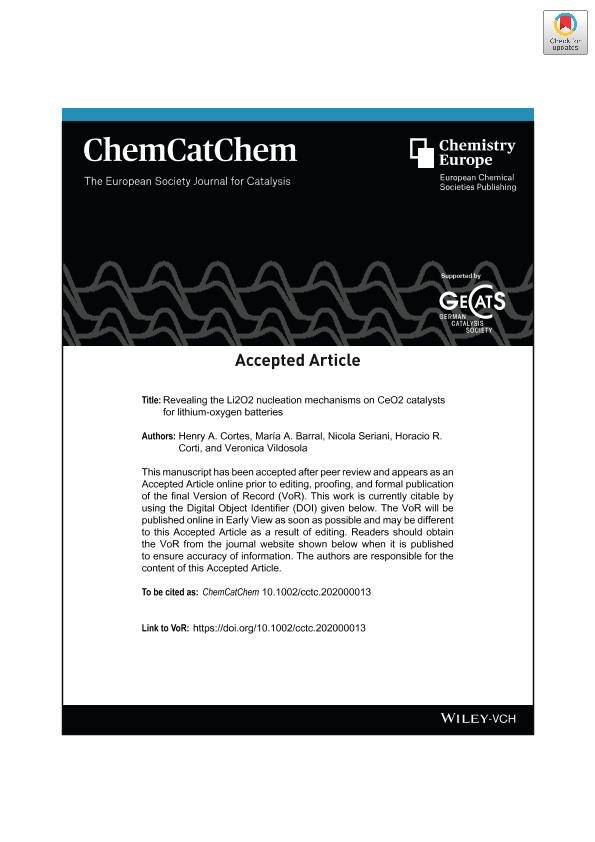Mostrar el registro sencillo del ítem
dc.contributor.author
Cortés Páez, Henry Andrés

dc.contributor.author
Barral, María Andrea

dc.contributor.author
Seriani, Nicola
dc.contributor.author
Corti, Horacio Roberto

dc.contributor.author
Vildosola, Veronica Laura

dc.date.available
2021-11-09T19:44:00Z
dc.date.issued
2020-08
dc.identifier.citation
Cortés Páez, Henry Andrés; Barral, María Andrea; Seriani, Nicola; Corti, Horacio Roberto; Vildosola, Veronica Laura; Revealing the Li2O2 nucleation mechanisms on CeO2 catalysts for lithium‐oxygen batteries; Wiley VCH Verlag; Chemcatchem; 12; 16; 8-2020; 4132-4137
dc.identifier.issn
1867-3880
dc.identifier.uri
http://hdl.handle.net/11336/146501
dc.description.abstract
The addition of ceria (CeO2) nanoparticles to the cathode of a lithium-oxygen battery results in increased capacity, lower overpotentials and better cyclability. To shed light on the mechanisms of this performance enhancement, we have investigated the early stages of Li2O2 nucleation at stoichiometric and reduced ceria surfaces by means of atomistic simulations based on density functional theory. Adsorption energies are stronger on ceria than on graphene, that is, nucleation mainly would take place on the oxide. The adsorption process of O2 is the one that determines the nucleation sites for the Li2O2 formation on the different CeO2 surfaces. The LiO2 intermediate is adsorbed at the O2 reduction sites. On the reduced (100) surface, the LiO2 tends to adsorb dissociatively, opening up the possibility to the formation of other species than the desired end-product, Li2O2. On the contrary, optimal properties are found for the reduced (110) surface, which should therefore be the most active surface for Li2O2 nucleation among all low-index surfaces of ceria. These findings could pave the route to produce better cathodes for Li-oxygen batteries by the addition of carefully designed ceria nanoparticles, which maximizes the exposition of the most favorable facet.
dc.format
application/pdf
dc.language.iso
eng
dc.publisher
Wiley VCH Verlag

dc.rights
info:eu-repo/semantics/openAccess
dc.rights.uri
https://creativecommons.org/licenses/by-nc-sa/2.5/ar/
dc.subject
CERIUM OXIDE CATALYST
dc.subject
FIRST PRINCIPLES CALCULATIONS
dc.subject
LITHIUM PEROXIDE NUCLEATION
dc.subject
LITHIUM-OXYGEN BATTERY
dc.subject.classification
Otras Ciencias Naturales y Exactas

dc.subject.classification
Otras Ciencias Naturales y Exactas

dc.subject.classification
CIENCIAS NATURALES Y EXACTAS

dc.title
Revealing the Li2O2 nucleation mechanisms on CeO2 catalysts for lithium‐oxygen batteries
dc.type
info:eu-repo/semantics/article
dc.type
info:ar-repo/semantics/artículo
dc.type
info:eu-repo/semantics/publishedVersion
dc.date.updated
2021-09-07T18:34:48Z
dc.journal.volume
12
dc.journal.number
16
dc.journal.pagination
4132-4137
dc.journal.pais
Alemania

dc.journal.ciudad
Weinheim
dc.description.fil
Fil: Cortés Páez, Henry Andrés. Consejo Nacional de Investigaciones Científicas y Técnicas. Oficina de Coordinación Administrativa Ciudad Universitaria. Unidad Ejecutora Instituto de Nanociencia y Nanotecnología. Unidad Ejecutora Instituto de Nanociencia y Nanotecnología - Nodo Constituyentes | Comisión Nacional de Energía Atómica. Unidad Ejecutora Instituto de Nanociencia y Nanotecnología. Unidad Ejecutora Instituto de Nanociencia y Nanotecnología - Nodo Constituyentes; Argentina
dc.description.fil
Fil: Barral, María Andrea. Consejo Nacional de Investigaciones Científicas y Técnicas. Oficina de Coordinación Administrativa Ciudad Universitaria. Unidad Ejecutora Instituto de Nanociencia y Nanotecnología. Unidad Ejecutora Instituto de Nanociencia y Nanotecnología - Nodo Constituyentes | Comisión Nacional de Energía Atómica. Unidad Ejecutora Instituto de Nanociencia y Nanotecnología. Unidad Ejecutora Instituto de Nanociencia y Nanotecnología - Nodo Constituyentes; Argentina
dc.description.fil
Fil: Seriani, Nicola. The Abdus Salam. International Centre for Theoretical Physics; Italia
dc.description.fil
Fil: Corti, Horacio Roberto. Consejo Nacional de Investigaciones Científicas y Técnicas. Oficina de Coordinación Administrativa Ciudad Universitaria. Instituto de Química, Física de los Materiales, Medioambiente y Energía. Universidad de Buenos Aires. Facultad de Ciencias Exactas y Naturales. Instituto de Química, Física de los Materiales, Medioambiente y Energía; Argentina. Consejo Nacional de Investigaciones Científicas y Técnicas. Oficina de Coordinación Administrativa Ciudad Universitaria. Unidad Ejecutora Instituto de Nanociencia y Nanotecnología. Unidad Ejecutora Instituto de Nanociencia y Nanotecnología - Nodo Constituyentes | Comisión Nacional de Energía Atómica. Unidad Ejecutora Instituto de Nanociencia y Nanotecnología. Unidad Ejecutora Instituto de Nanociencia y Nanotecnología - Nodo Constituyentes; Argentina
dc.description.fil
Fil: Vildosola, Veronica Laura. Consejo Nacional de Investigaciones Científicas y Técnicas. Oficina de Coordinación Administrativa Ciudad Universitaria. Unidad Ejecutora Instituto de Nanociencia y Nanotecnología. Unidad Ejecutora Instituto de Nanociencia y Nanotecnología - Nodo Constituyentes | Comisión Nacional de Energía Atómica. Unidad Ejecutora Instituto de Nanociencia y Nanotecnología. Unidad Ejecutora Instituto de Nanociencia y Nanotecnología - Nodo Constituyentes; Argentina
dc.journal.title
Chemcatchem

dc.relation.alternativeid
info:eu-repo/semantics/altIdentifier/url/https://chemistry-europe.onlinelibrary.wiley.com/doi/10.1002/cctc.202000013
dc.relation.alternativeid
info:eu-repo/semantics/altIdentifier/doi/http://dx.doi.org/10.1002/cctc.202000013
Archivos asociados
